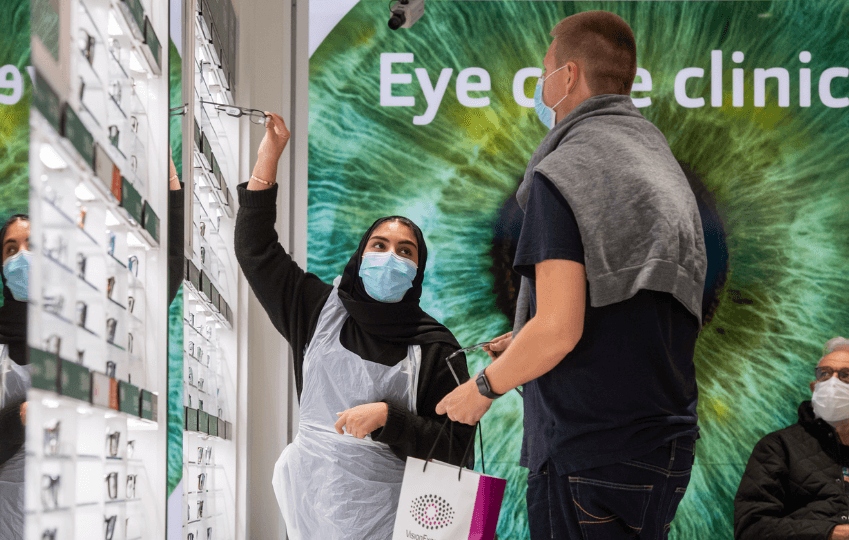What equipment is used in a standard eye care test
When you think back to your last eye care test, what does your memory conjure up? You probably remember being asked to look at a Snellen eye chart and list off the letters as they decrease in size with each new row. How about the equipment? You’ll have seen a fair few devices fitted around the room and you might have wondered what each one is used for.
What equipment can you find across all Vision Express stores?
Optometry is an advanced field of medicine and our understanding of vision only continues to grow. One reason we're able to continue learning more about the human eye is because of the equipment available to us. There are a number of different devices that all optometrists at Vision Express are trained to use and here's a quick summary of them.
Slit Lamp
The eye health checks will normally start with a slit lamp, which is a microscope that directs a beam of light into the eye to get a full picture of the sclera, cornea, lens, retina and optic nerve.
Visual Fields
The visual field equipment we use may differ from one store to the next, but the purpose is the same, regardless of the name. Optometrists will use this equipment to test the range of our vision, checking for any blind spots. If there's any change in peripheral vision from one test to the next, optometrists will know to watch out for things such as glaucoma, diabetes, and optic nerve damage.

Fundus Camera
You can think of a fundus camera as a microscope with a camera built in. Sounds pretty high tech right? While this device is used in a standard eye care test, it is some pretty nifty equipment that lets optoms take a picture of the interior surface of the eye, also known as the fundus.
Combined Keratometer, AutoRefractor and Tonometer
Think of this piece of equipment as a three-in-one, that uses high-speed measurements to paint a picture of the curvature of the cornea, how a person's visual system refracts light, and their intraocular pressure (IOP).
These tests are used by Optometrists for contact lens fitting, determining whether a patient is a good candidate for laser eye surgery, and checking for cataracts, among many other things. A lot of power is packed into just one device, which saves us space in our testing room.
Contact Tonometers
While non-contact tonometers will use a puff of air to test the pressure of your eye, contact tonometers rely on contact with the eye, as the name would suggest. A flat-tipped probe is carefully pressed against an anaethetised eye surface to get a more accurate measurement of the IOP. Again, this is used to determine if a patient is at risk of glaucoma or if they are experiencing loss of peripheral vision, blurred vision or halos around lights. While this isn’t used for most eye tests; it is a vital tool if referral may be required.
It’s our ambition is to have the following equipment in all stores by the end of 2023
Optometry is an ever-evolving field, and we're always looking to bring the latest technology to our stores. Here are a few devices we've started to introduce to our standard testing rooms.
Auto-Phoropters
Until recently, optometrists could only check someone’s spectacle prescription by selecting lenses from a box and inserting them into a specially designed frame.
Many stores now have the option of using an Auto-Phoroptor which uses a computer to change the lenses on a free standing head unit. This allow for a more comfortable experience for the customer and a huge variety of lens options for the Optometrist to use at the click of a button!
Optical Coherence Tomography (OCT)
An OCT scan is an additional, more in depth test on top of the standard eye examination. The machine gives our optometrists a detailed view of the inner eye, including the layers of the retina. The digital retinal photography used is very similar to that of a standard eye test, however, this more advanced 3D imagery is used when testing for more serious eye conditions. These are available in a lot of our Vision Express stores already and we plan for OCT machines to be available in all stores by the end of 2023.
Are you passionate about vision?
Taking care of people’s sight is one of the most important jobs out there. Which is why we’re proud to do what we do. But we couldn’t do it without talented optometry professionals who are passionate about vision.
Now that you know the equipment that we use in our stores, perhaps you want to learn more about the people behind the lens? Take Graeme for example. He's built an impressive career here at Vision Express, and optometry is more than just a job to him. It’s a chance to gain professional qualifications and use those to help people see better. Does it get much better than that?
If you’re feeling inspired, head straight to our optometrist vacancies, dispensing optician jobs or contact lens optician roles. Or explore our retail assistant roles to learn more about how you could start a career with us.
Sign up for posts
Life at Vision Express

Teaser
Eyecare ProfessionalContent Type
PostPublish date
02/13/2024
Summary
In a world where the definition of a perfect work-life balance is constantly evolving, at Vision Express, we want to stand out as a beacon for Eyecare Professionals that are seeking not just a job,

by
Meeraj Gokani

Teaser
Eyecare ProfessionalContent Type
PostPublish date
01/25/2024
Summary
There are many things to think about when looking for the next step in your career, and one of the biggest considerations could be the flexibility of the role.Maybe you’re looking for set hours t

by
Meeraj Gokani

Teaser
Eyecare ProfessionalContent Type
PostPublish date
03/22/2023
Summary
Optometrists are professionals with a lot of knowledge and as an optometrist, your CV needs to reflect that. Your CV is how you get your foot in the door and is your first impression on your potenti

by
Meeraj Gokani

Teaser
Eyecare ProfessionalContent Type
PostPublish date
03/07/2023
Summary
The future of the eyecare industry is looking bright, with the estimated global eyewear market value for 2030 coming in at 270.8 billion pounds. Opticians are and will continue to be in high demand.

by
Meeraj Gokani

Teaser
Eyecare ProfessionalContent Type
PostPublish date
03/06/2023
Summary
From prescribing lenses to diagnosing and treating eye diseases, optometrists are highly skilled professionals with unique expertise that is in high demand. The optometry industry is rapidly evolvin

by
Meeraj Gokani

Teaser
Pre-RegistrationContent Type
PostPublish date
03/01/2023
Summary
Becoming a pre-registration optometrist can be a challenging and rewarding experience. As you work towards your goal of becoming a fully qualified optometrist, you’ll have the opportunity to develop

by
Meeraj Gokani

Teaser
GeneralContent Type
PostPublish date
02/20/2023
Summary
The 2022 General Optical Council report surveyed optical professionals around the country and found that more people were satisfied in their current roles. Why might this be? Optometry is the place

by
Meeraj Gokani

Teaser
GeneralContent Type
PostPublish date
01/11/2023
Summary
You'll have come across a fair few Vision Express stores, but did you know we have as many as 600 dotted around the UK? Each and every day, our customers rely on these stores to stay open so we

by
Meeraj Gokani

Teaser
Eyecare ProfessionalContent Type
PostPublish date
01/09/2023
Summary
Optometry is an ever-changing industry with plenty of directions to take your career. That amount of choice means you can shape your career to what you want. But it can leave you questioning which

by
Meeraj Gokani

Teaser
Eyecare ProfessionalContent Type
PostPublish date
01/05/2023
Summary
It's no secret that we're proud of our game-changing leadership. The people that lead our teams are both ambitious and inspiring. They know how to rally their team together so that everyone is c

by
Meeraj Gokani
Related jobs
Salary
Location
Basingstoke - Tesco
Job type
Permanent
Internal or External
Internal
External
Location
England
Basingstoke
Job area
Optometrist
Description
Role overview As an Optometrist at Vision Express, you’ll get to work with some world class technology including automated refraction, non-contact tonometry, automated keratometry, fundus camera, v
Reference
9579
Expiry Date
01/01/0001
Salary
Location
Cirencester - Tesco
Job type
Permanent
Internal or External
External
Location
England
Cirencester
Job area
Optometrist
Description
Role overview As an Optometrist at Vision Express, you’ll get to work with some world class technology including automated refraction, non-contact tonometry, automated keratometry, fundus camera, v
Reference
161
Expiry Date
01/01/0001
Salary
Location
Whitstable - Tesco
Job type
Permanent
Internal or External
External
Location
England
Whitstable
Job area
Optometrist
Description
Role overview As an Optometrist at Vision Express, you’ll get to work with some world class technology including automated refraction, non-contact tonometry, automated keratometry, fundus camera, v
Reference
164
Expiry Date
01/01/0001
Salary
Location
Portsmouth - Tesco
Job type
Permanent
Internal or External
External
Location
England
Portsmouth
Job area
Optometrist
Description
Role overview As an Optometrist at Vision Express, you’ll get to work with some world class technology including automated refraction, non-contact tonometry, automated keratometry, fundus camera, v
Reference
168
Expiry Date
01/01/0001
Salary
Location
Broadstairs
Job type
Permanent
Internal or External
External
Location
England
Broadstairs
Job area
Optometrist
Description
Role overview As an Optometrist at Vision Express, you’ll get to work with some world class technology including automated refraction, non-contact tonometry, automated keratometry, fundus camera, v
Reference
173
Expiry Date
01/01/0001
Salary
Location
Andover.
Job type
Permanent
Internal or External
External
Location
England
Andover
Job area
Optometrist
Description
Role overview As an Optometrist at Vision Express, you’ll get to work with some world class technology including automated refraction, non-contact tonometry, automated keratometry, fundus camera, v
Reference
175
Expiry Date
01/01/0001
Salary
Location
Taunton.
Job type
Permanent
Internal or External
External
Location
England
Taunton
Job area
Optometrist
Description
Role overview As an Optometrist at Vision Express, you’ll get to work with some world class technology including automated refraction, non-contact tonometry, automated keratometry, fundus camera, v
Reference
176
Expiry Date
01/01/0001
Salary
Location
Yeovil - Tesco
Job type
Permanent
Internal or External
External
Location
England
Yeovil
Job area
Optometrist
Description
Role overview As an Optometrist at Vision Express, you’ll get to work with some world class technology including automated refraction, non-contact tonometry, automated keratometry, fundus camera, v
Reference
177
Expiry Date
01/01/0001
Salary
Location
Llansamlet, Swansea - Tesco
Job type
Permanent
Internal or External
External
Location
England
Llansamlet
Job area
Optometrist
Description
Role overview As an Optometrist at Vision Express, you’ll get to work with some world class technology including automated refraction, non-contact tonometry, automated keratometry, fundus camera, v
Reference
186
Expiry Date
01/01/0001
Salary
Location
Yeovil.
Job type
Permanent
Internal or External
External
Location
England
Yeovil
Job area
Optometrist
Description
Role overview As an Optometrist at Vision Express, you’ll get to work with some world class technology including automated refraction, non-contact tonometry, automated keratometry, fundus camera, v
Reference
497
Expiry Date
01/01/0001
.jpg)
Share in our stories
Everyone has an important part to play in our continuing success – whatever their role, their experience or their area of expertise. We’ve chosen some colleagues to give you a brief insight into what life’s like at Vision Express.
Read more

